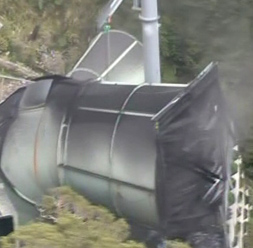Brits among trapped New Zealand miners
Two Brits are among 29 men trapped by an explosion in a New Zealand mine. An expert tells Channel 4 News the risk of another gas blast makes it hard to tell when a rescue attempt could be made.
The 29 miners became trapped after an explosion in the New Zealand mine on Friday at around 3.30pm local time.
Pete Rodger, 40, from Perthshire, Scotland, and 25-year-old Malcolm Campbell from Fife, Scotland, are amongst those caught in the blast.
Five men escaped and are being treated in hospital, but the other men remain underground in the Pike River Coal Mine in Atarau. It is not known if they survived the original explosion.
Rescue
A rescue mission to reach the workers has been hampered over fears that dangerous gas deep in the mine could trigger a second dangerous explosion.
Pike River Mine‘s chief executive Peter Whittall said: “We can’t risk sending men into the mine until we know exactly what [the quality of the gas] is.”
He said the men underground were likely to be facing hazards including air pollution, high levels of methane and carbon dioxide, and low oxygen levels.
Readings taken on Saturday suggested that a second explosion could be imminent.

'The gas all coal miners fear'
Methane is the gas all coal miners fear, writes Science Correspondent Julian Rush. At concentrations of 5 to 15 per cent in the air in the mine it is explosive, which is why ventilation is so critical to mine safety underground.
It is odourless, so mines have methane detectors. Great care is taken to design electrical equipment to avoid sparks that might trigger an explosion. Sir Humphrey Davy's invention of the lamp that bears his name paved the way for the safer exploitation of deeper and more dangerous coal mines that fuelled Britain's Victorian industrial expansion.
Methane - chemical symbol CH4 - is found in almost every coal mine in the world, the product of the original geological processes that turned lush forests to buried coal. Known to miners as "firedamp", it is a familiar hazard; the very act of mining releases it from the pockets in the coal seam where it has been trapped.
Union representative Trevor Bolderson said: “Gas samples taken at the mine are turning the wrong way and we are expecting that the second explosion may be forthcoming. At the moment the rescue guys can’t get into the mine because of this.”
The mayor of nearby Greymouth, Tony Kokshoorn, said it could be days before it is safe enough to send rescue teams down the mine shaft.
Underground mine rescue instructor Robert Murray Willis told Channel 4 News it was unclear when the mine may be safe.
“If it is not safe and they go in, they create more hazards, both for the mine rescue team and for the miners,” he said.
“The big difference with this mine rescue and the Chile mine is this is a gaseous mine – in a coal seam there are ethanes, methane, and carbon dioxide – all of which are inflammable and posionous.”
“It is a tight balance between causing a bigger accident and rescuing the possible survivors alive.” Mine rescue expert Robert Murray Willis
He said Superintendent Gary Knowles, who is in charge of the rescue mission, was handling the rescue “in a thorough and proper way”.
“There is no other option,” Mr Murray Willis, who now runs an insurance business, said. “It is a tight balance between causing a bigger accident and rescuing the possible survivors alive.”
He said assessing when they miners could be rescued was a “difficult question”.
“We don’t know when the gas levels may change. There could be further leakages – while they are drilling they could drill into a pocket of methane – they have to go step by step,” he said.
Support
Foreign Secretary William Hague said: “I am saddened to hear the news of the explosion at Pike River Coal mine in the South Island of New Zealand.
“My thoughts are with those who are missing, and also with their families and friends, who are awaiting news. Two British citizens are amongst those missing.”
Prime Minister David Cameron is being kept informed of developments.
“Clearly he is deeply concerned about the appalling situation there,” a No 10 spokeswoman said. “Clearly we stand ready to provide any assistance that is required.”
'Terrifying' explosion
In the confined space of a coal mine, a methane explosion is terrifying, writes Science Correspondent Julian Rush. The shock wave blasting through the mine can loosen huge quantities of coal dust, itself very explosive, risking a secondary blast and a fireball that races through the workings.
The ventilation shaft was damaged by the blast, but the layout of the Pike River Mine means it has natural ventilation and the compressors pumping fresh air into the mine are still working.
Pike River is a modern mine, operating under regulations that require high ventilation standards to minimise the risk of explosion. It only opened in 2008 and the men are equipped with personal breathing apparatus that lasts 30 minutes to an hour, giving them time to reach refuges where there are extra oxygen supplies.
Pike River has been operating in the area since 2008, mining a rich coal seam on New Zealand’s South Island. The location of the mine is not far from one of New Zealand’s worst mining disasters – an underground explosion in the state-owned Strongman Mine in 1967, which killed 19 workers.
Messages of support have been pouring in from across the globe, as the miners’ families cling to hope that the story will have a similar happy ending to that of the Chile miners, who survived their ordeal after 69 days underground.